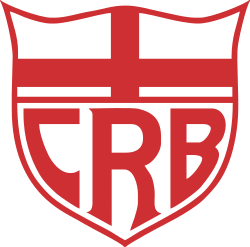Clube de Regatas Brasil
 From Wikipedia - Reading time: 9 min
From Wikipedia - Reading time: 9 min
This article needs additional citations for verification. (May 2022) |
 | ||||
| Full name | Clube de Regatas Brasil | |||
|---|---|---|---|---|
| Nickname(s) | Galo (de Campina) (Red-cowled Cardinal) Galo da Praia (Cardinal of the Beach) | |||
| Founded | 20 September 1912 | |||
| Ground | Rei Pelé | |||
| Capacity | 19,105 | |||
| President | Mário Marroquim | |||
| Head coach | Umberto Louzer | |||
| League | Campeonato Brasileiro Série B Campeonato Alagoano | |||
| 2024 2024 | Série B, 16th of 20 Alagoano, 1st of 8 (champions) | |||
| Website | www | |||
|
| ||||
Clube de Regatas Brasil, commonly referred to as CRB, is a Brazilian professional football club based in Maceió, Alagoas. It competes in the Série B, the second tier of Brazilian football, as well as in the Campeonato Alagoano, the top flight of the Alagoas state football league.
Founded on 20 September 1912, it plays in white and red shirts, shorts and socks. Its greatest rival is Centro Sportivo Alagoano (CSA),
History
[edit]The club was founded on 20 September 1912 by Lafaiete Pacheco, former member of Clube Alagoano de Regatas. He was dissatisfied with the precarious conditions of his former club. Aroldo Cardoso Zagallo, father of Mário Jorge Lobo Zagallo, worked at the club in 1913 as the football department boss.
Four years later, in 1916, CRB bought an estate in Pajuçara neighborhood and built its football field where is now Severiano Gomes Stadium.
Rivalries
[edit]CRB's greatest rival is CSA.
On 1 October 1939, CRB beat CSA 6–0, in what was the biggest win in the rivalry's history. The game was known as "Jogo da Sofia" (Sofia's game), which is a reference to a goat named Sofia and owned by CRB's forward Arlindo, as the goat is the number six animal in Jogo do Bicho.[1]
Numbers of the derby
- Games: 474
- CRB wins: 171
- Draws: 156
- CSA wins: 148
- CRB goals: 579
- CSA goals: 606
Stadium
[edit]The club plays at Estádio Rei Pelé, which has a maximum capacity of 19,105 people and is named after Pelé.
Honours
[edit]Official tournaments
[edit]| State | ||
|---|---|---|
| Competitions | Titles | Seasons |
| Campeonato Alagoano | 35 | 1927, 1930, 1937, 1938, 1939, 1940, 1950, 1951, 1961, 1964, 1969, 1970, 1972, 1973, 1976, 1977, 1978, 1979, 1983, 1986, 1987, 1992, 1993, 1995, 2002, 2012, 2013, 2015, 2016,[2] 2017, 2020, 2022, 2023, 2024, 2025 |
Others tournaments
[edit]Regional
[edit]- Torneio José Américo de Almeida Filho (1): 1975
State
[edit]- Copa Maceió (1): 2015
- Torneio Início de Alagoas (15): 1936, 1937, 1939, 1943, 1944, 1945, 1946, 1951, 1956, 1958, 1962, 1963, 1966, 1969, 1970
Runners-up
[edit]- Campeonato Brasileiro Série C (1): 2011
- Copa do Nordeste (2): 1994, 2024
- Campeonato Alagoano (28): 1928, 1941, 1942, 1944, 1946, 1948, 1949, 1958, 1959, 1963, 1968, 1971, 1974, 1975, 1980, 1981, 1982, 1984, 1985, 1994, 1996, 1997, 1998, 2003, 2014, 2018, 2019, 2021
Women's Football
[edit]- Campeonato Alagoano de Futebol Feminino (1): 2021
Current squad
[edit]- As of 29 May 2025
Note: Flags indicate national team as defined under FIFA eligibility rules; some limited exceptions apply. Players may hold more than one non-FIFA nationality.
|
|
Youth team
[edit]Note: Flags indicate national team as defined under FIFA eligibility rules; some limited exceptions apply. Players may hold more than one non-FIFA nationality.
|
Out on loan
[edit]Note: Flags indicate national team as defined under FIFA eligibility rules; some limited exceptions apply. Players may hold more than one non-FIFA nationality.
|
All presidents in club history
[edit]
1910s and 1920s[edit]
1930s and 1940s[edit]
1950s and 1960s[edit]
|
1970s and 1980s[edit]
1990s and 2000s[edit]
|
References
[edit]- ^ (in Portuguese) O jogo da Sofia – 1939 – Museu dos Esportes Archived 6 September 2002 at the Wayback Machine
- ^ "Tabela | campeonato alagoano".
External links
[edit]- Official website
- CRB-NET (archived 20 August 2006)
 KSF
KSF